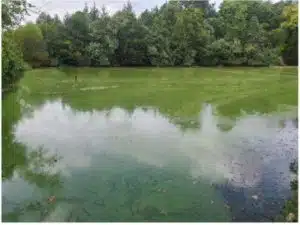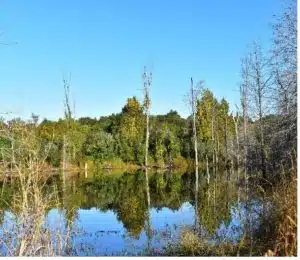Managing water quality in Conservancy ponds is more difficult when ponds experience higher amounts of
water runoff from neighborhood streets. When looking at Allen Farm Pond or Cedar Pond, our two most
intensely managed ponds, the green algae spreading across the water surface is incredibly noticeable. This is
true particularly in the spring and fall when these ponds struggle with algae blooms and muddy colors that
stem from the water runoff from the neighborhood.
Phosphorous is one of the three main components of fertilizer, making up 10% of the fertilizer applied to
lawns and gardens, and during rain events phosphorous gets washed into ponds and streams. To put this into
perspective, while phosphorous makes up 10% of fertilizer, in healthy waterways it should only make up
0.000002% of the nutrients in the water.
When a high percentage of phosphorous gets added to the water it feeds the growth of algae and causes a
massive blooming event. Not only does this give the pond a green and slimy appearance, but it reduces
oxygen in the water and makes it less livable for fish and toxic to animals.
What does the Conservancy do to manage algae bloom? The application of naturally occurring additives can
help rebalance the nutrient levels. This gradual and natural restoration is preferred to chemical applications
of algaecides which can harm the wildlife and the sudden death of vegetation can cause a massive vacuum of
oxygen during the decaying process that can cause fish die-off.
Unfortunately, reducing the amount of phosphorous in water is an uphill battle and some ponds such as
Cedar Pond struggle more each year. The biggest impact is lawn fertilizer.
What can the Community do? Our community can help ponds and wildlife by reducing the use of fertilizer
or by using phosphorous free fertilizer. One way to reduce the use of fertilizer is to adopt a practice of soil
testing to determine exactly what nutrient the lawn needs and how much. This prevents an overapplication
of fertilizer that causes a chain of bad reactions in the environment. The wise use of fertilizer can help save
our water & wildlife.
Interested in seeing how much of a difference fertilizer really makes? Cedar Pond has water running into it
from 70 different homes and it gets treated every two weeks to combat algae blooms. As you can see from
the photo below, it is still struggling to rebalance and there is a growing algae problem. In contrast, Beaver
Dam Pond has water runoff from 17 homes and currently has zero algae and requires no treatment.

Cedar Pond

Beaver Dam Pond